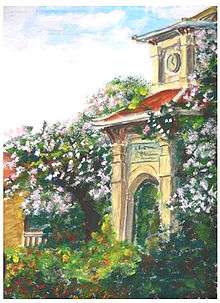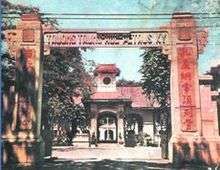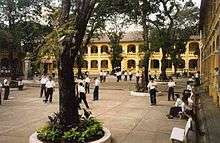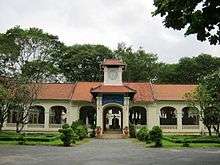Lê Hồng Phong High School
Lê Hồng Phong High School for the Gifted (Vietnamese: Trường Phổ Thông Trung Học Chuyên Lê Hồng Phong; formerly known as Petrus Ký High School) is a high school in Hồ Chí Minh City, Vietnam. Established in 1927, the school is one of the oldest high schools still operating in Vietnam.
| Lê Hồng Phong High School for the Gifted Trường Trung học Phổ Thông Chuyên Lê Hồng Phong | |
|---|---|
 by Nguyễn Hoàng Việt, alumnus, 2003-06 | |
| Address | |
235 Nguyễn Văn Cừ Street, District 5 , 700000 | |
| Coordinates | 10°45′54″N 106°40′55″E |
| Information | |
| Former name | Petrus Ký High School |
| Type | Public |
| Established | 1927 |
| Principal | Phạm Thị Bé Hiền |
| Faculty | 152 |
| Gender | Co-educational |
| Enrollment | 2045 |
| Campus size | 20 acres |
| Campus type | Urban |
| Color(s) | White and Navy blue |
| Website | Official website (in Vietnamese) |
History
Lê Hồng Phong High School for the Gifted was the third high school founded in Saigon by French colonizers, after the Collège Chasseloup-Laubat (now Le Quy Don High School) and Collège de Jeunes Filles Indigènes (now Nguyễn Thị Minh Khai High School). In 1925, Architect Ernest Hebrard was commissioned to design a school in Chợ Quán.
On 28 November 1927, a temporary branch of Collège Chasseloup-Laubat, called Collège de Cochinchine, was founded in Chợ Quán for native students. The branch was under the management of the Board at Collège Chasseloup-Laubat.



The construction of the school was completed in 1928. On 11 August 1928, the interim Governor-General of French Indochina, René Robert, signed Decree no. 3116 to establish a native French secondary school (Lycée), combining Collège de Cochinchine and about 200 pupils from Collège Chasseloup Laubat. The Governor Blanchard de la Brosse named the school Lycée Petrus Trương Vĩnh Ký, in honour of the Vietnamese Catholic who served the French colonial government. The school was known as Petrus Ký High School for almost a half-century.
Lycée Petrus Truong Vinh Ky, commonly referred to as Lycée Petrus, commenced the first day on October 1, 1928. The first principal was Mr. Sainte Luce Banchelin, the bureau's Mr. Boulé, the banker Mahé. The chairman of the board is Mr. Gazano and the Vietnamese members are: Mr. Nguyen Thanh Giung, Ph.D., chemist, contract professor, Mr. Ho Bao Toan and Mr. Tran Le Quat. The officials are parents French commissioners Sainte Luce Banchelin and Mahé. The president is the Principal and the members are: John, Painting Professor, Mr. Paquier, Professor of Literature, Mr. Nguyen Van Nho, Professor of Literature, Mr. Nguyen Van Thuong, and supervisor and secretary is Mr. Boulé.
There are two levels of study: Enseignement primaire supérieur Franco-indigène (DEPSI) and French Secondary (enseignement secondaire Franco-indigène).
The first course consisted of 10 students who received a partial scholarship and 43 students who received a full scholarship. This grade was divided into 3 classes: 1ère année, 2ème année and 3ème année. 18 classes: 3 classes 4ème année, 5 classes 3ème année, 5 classes 2ème année and 5 classes 1ère année. In this school year, Tran Van Trach, special commissioner of Nam Ky Governor bought books for the Petrus Ky Library. In the school year 1928-1929 was the subject of social concern through an article published in the newspaper La Tribune Indochinoise on January 4, 1929 with content Lycée Petrus Ky for native students treated as relatives. After the paper, in the second academic year, Mr. Banchelin was renamed and Mr. Paul Valencot, a professorial master of master's degree, was appointed principal in August 1929 and the Governor of Nam appointed Mr. Renault, chairman of the Cholon Marketing Board, replacing Mr. Gazano as the chairman of the board.
In 1941, the school was temporarily relocated to the Pedagogical College of Saigon due to the war. It resumed its regular teaching activities in the same year, at its own establishment. In 1945, the school was temporarily closed after evacuating to Tân Dĩnh district. It re-opened in April 1946 in a seminary on Lucien Mossard street. It returned to Chợ Quán in the year 1947.
In 1961, it became a secondary school in the Southern Vietnamese educational system. In 1976, the school was renamed after a former general secretary of the Communist Party of Vietnam, Lê Hồng Phong, and became a high school. In 1990, it was made a high school for the gifted students. Its current name is Lê Hồng Phong High School for the Gifted.
Institution
A faculty of about 160 teachers, chosen from the top candidates at the National University of Education in Ho Chi Minh City, serves about 2400 students in three grades from 10th to 12th. Lê Hồng Phong conducts a rigorous entrance examination for admission. Its long-standing prestige as the foremost high school in the area attracts many applicants from South Vietnam and the competition is fierce. Students sit for exams in mathematics, literature, English, and must write a paper on one of the eleven subjects offered in the classes for majors. Students applying for the bilingual Vietnamese-French programme are admitted on a different panel.
In the 2006-07 academic year, the school admitted 250 students into 12 classes for majors and 400 students into 8 classes for non-majors.


The school offers 12 classes for majors, each specialising in a single subject: Mathematics, Physics, Computer science, Chemistry, Biology, Geology, History, Literature, English, French, Chinese and Japanese. Students in these classes do not have to pay tuition fees. Students in those courses are awarded a significant scholarship if they are at the top 30% of students at the end of the semester.
Upon applying to Lê Hồng Phong, applicants must either specify the major they would like to apply for, or select the Section in which they want to predominantly study in for non-major classes. A section is a study programme in which the student chooses to specialize in three out of the eleven mandatory subjects which corresponds to the College and University entrance exam system in Vietnam. The entrance examination papers for each section differ in level of difficulty of each subject.
- Section A: Mathematics, Physics and Chemistry.
- Section B: Mathematics, Chemistry and Biology.
- Section C: Literature, History and Geography.
- Section D: Mathematics, Literature and foreign languages.
Students in the classes for non-majors pay nominal tuitions. The bilingual French-Vietnamese programme is taught in both languages. At the end of 12th grade, students attend two examinations: the Vietnamese National Baccalaureate and the Bilingual Baccalaureate recognized by the Francophone community. The prominent student organisation at Lê Hồng Phong is the Youth Division of the Communist Party of Vietnam. The organisation organises annual recreational and charity events, many of which have become school traditions.
Almost 100% of the school's students pass the National Baccalaureate examination and more than 90% gain entrance to universities and colleges. The school is a strong contestant in the national and international student academic competitions. In the 2006-2007 school year, 291 students from Lê Hồng Phong won the City Student Academic Aptitude competition in 12 subjects and 23 students won the National competitions. It is one of the two best-known high schools in Hồ Chí Minh City, together with High school for the Gifted (Nang Khieu High School).[1]
Recognitions
- In 1989, the school was awarded the 3rd Level Labour Medal by the President of Vietnam.
- In 2001, the school was awarded the 2nd Level Labour Medal by the President of Vietnam.
- In 2007, the school was awarded the 1st Level Labour Medal by the President of Vietnam.[2].
Staff
The school has 20 departments whose staff bear different responsibilities of teaching and operating the institution.
In 2018, Le Hong Phong department of Mathematics has 26 teachers who are graduated from the higher education system, including 1 doctor, 8 masters and many teachers who are studying postgraduate. Group teachers are well-versed in their teaching and have extensive experience in teaching, actively contributing to the school's activities, training generations of excellent students for the City and Country. The dynamic and creative young teachers have great potential to take part in teaching profession and fostering good students effectively. The Maths Team is a solid, friendly, professional, experienced and enthusiastic team. Following the textbook program of the Ministry of Education, the Mathematical Team organizes the application of unified documents for each block 10, 11, 12 very effective. Mathematical teams take the lead in applying information technology to teaching, there is always innovation in teaching methods. In addition, the Math Club offers an extra-curricular course for students to solve mathematical calculations using Casio's pocket calculator and has achieved high rankings in both the City and State levels. For many years, the team has won the title of "Excellent Labor Collective" - many of them have received certificates of merit from the People's Committee, the Ministry of Education and Training, the Prime Minister and many noble rewards. Other achievements in teaching and fostering good students.[3]
Academic reputation
In 2018, the school admitted fewer 500 highest-scored students (from total 3252 applicants are widely considered to be the most competitive out of 70,054 students in the same year) [4] through the annual year-10 academic entrance examination.[5][6] The school has remained the most selective one in South Vietnam for nearly a century since its establishment.
Petrus Ky students in the war era
In 1940, the Petrus Ký Student Club was founded. The club organised extra-curricular activities including performing arts, sports, camping, attracting students from within and outside Petrus Ký. It was during this time that the students Lưu Hữu Phước and Mai Văn Bộ (in Vietnamese) (later ambassador) wrote "La Marche des Étudiants" song, the predecessor of the patriotic "Tiếng Gọi Thanh Niên (Call to the Young)", "Tiếng Gọi Công Dân (Call to the Citizens)" and "Quốc Ca của Việt Nam Cộng Hòa (The National Anthem of the Republic of Vietnam, National anthem of South Vietnam)".[7][8]
Within a year, the club and its activities were prohibited by the French-Indochina government. In 1942, Petrus Ký students, inspired by students in Hanoi, founded an organisation named S.E.T. (Section Exécution Tourisme). The organisation functioned as a scout programme aiming at developing character, citizenship, and personal fitness qualities. During this time, several Petrus Ký professors such as Phạm Thiều, Lê Văn Chí and Trần Văn Thanh, also subtly professed their patriotism in lectures.
As France re-occupied Vietnam, in 1948, Petrus Ký students were the leaders in the movement "Teach and Learn in Vietnamese". On 10 September 1949, the first day of the academic year, students of several schools together with scholars and parents went on strike. The government closed Petrus Ký and Gia Long schools and imprisoned a number of students.
On 9 January 1950, over 2000 students from Petrus Ký, Gia Long, Áo tím and Kỹ Thuật [...] protested in front of the Ministry of Education and then the Governor Palace. The government tried to disperse the crowd; however, the number of protesters had risen to more than 50,000. The police started firing into the crowd and Tran Van On, a student from Petrus Ký, was killed. Three days later, the city went on strike to attend On's funeral. Students from Mỹ Tho, Cần Thơ, Huế, and Hanoi came to Saigon to participate in the ceremony, carrying protesting banners. More than 1,000,000 people were present at the funeral. This was the largest funeral in Saigon since that of Phan Chu Trinh in 1925.
On 14 July 1954, Petrus Ký student started the movement to demand independence and democracy at the school by drawing slogans on walls and blackboards, openly supporting the Geneva Accord. On 30 March 1955, conflicts between the national army and Bình Xuyên arms broke out. Bình Xuyên's volunteer force stationed itself at Petrus Ký. On 30 April 1955, the national army expelled Bình Xuyên. On 1 May 1955, Petrus Ký students formed a committee to help victims of the conflict. The committee was able to gather considerable amount of money and aids for the people.
In 1970, Petrus Ký students organised a strike and a take-over of the Cambodian Embassy to protest against Lon Nol's massacre of Vietnamese expats living in Cambodia. In 1972, Nguyen Thai Binh, a school alumnus studying in the United States, participated in anti-war demonstrations and wrote a letter to then U.S. President Nixon condemning crimes against the Vietnamese people. While being deported from the U.S. back to Vietnam, he attempted to hijack the Pan American 747 as it approached Saigon. He was shot dead by a vacationing American police officer.
On 30 April 1975, the South Vietnam Liberation Force, headed by General Trần Văn Trà, was stationed at the school. The school was temporarily closed until July 1975 and the class of 1974-1975 took their final examinations and graduated in September 1975.
Principals
| School year | Principal |
|---|---|
| 1927–1929 | Sainte Luce Banchelin [9] |
| 1929–1931 | Paul Valencot [9] |
| 1931–1933 | Andre Neveu [9] |
| 1933–1938 | Paul Valencot[9] |
| 1938–1944 | Le Jeannic |
| 1944–1947 | Taillade |
| 1947–1951 | Lê Văn Khiêm |
| 1951–1955 | Phạm Văn Còn |
| 1955–1957 | Nguyễn Văn Kính |
| 1957–1958 | Nguyễn Văn Thơ |
| 1958–1960 | Nguyễn Văn Trương |
| 1960–1963 | Phạm Văn Lược |
| 1963–1964 | Nguyễn Thanh Liêm |
| 1964–1966 | Trần Ngọc Thái |
| 1966–1969 | Trần Văn Thử |
| 1969–1971 | Trần Ngọc Thái [9] |
| 1971-1971 | Trần Văn Nhơn [9] |
| 1971–1973 | Bùi Vĩnh Lập [9] |
| 1973–1975 | Nguyễn Minh Đức [9] |
| 1975–1977 | Nguyễn Văn Thiện |
| 1977–1991 | La Thị Hạnh |
| 1991–1997 | Nguyễn Hữu Danh |
| 1997–2005 | Đặng Thanh Châu |
| 2005–2013 | Võ Anh Dũng |
| 2014–2019 | Nguyễn Thị Yến Trinh [10] |
| 2019–present | Phạm Thị Bé Hiền [11] |
Notable alumni
- Trần Đại Nghĩa, military scientist, ingénieur, inventor
- Lê Tự Quốc Thắng, Professor in Mathematics, Georgia Institute of Technology, known for Le-Murakami-Ohtsuki invariant.
- Lê Diệp Kiều Trang, Facebook director in Vietnam [12]
- Trần Minh Triết, Vice President of University of Science, VNU-HCM [13]
- Cathy Thao Tran, Founder of Ohana
- Do Cao Tri - Army of the Republic of Vietnam general, commander of III Corps
- Le Minh Dao - Army of the Republic of Vietnam general, commander of the 18th Division
Politics and law
- Nguyễn Văn Chì [14]
- Trần Văn Ơn, political activist
- Huỳnh Tấn Phát
- Nguyễn Văn Trấn
- Mai Văn Bộ
- Huỳnh Văn Tiểng
- Trương Tấn Sang, seventh president of Vietnam
- Nguyễn Minh Triết, sixth president of Vietnam
- Nguyễn Thái Bình, anti-Vietnam war activist in United States
- Nguyễn Tiến Trung
- Tran Ngoc Lieng - lawyer
Culture
- Trúc Hồ
- Trần Văn Khê, Honorary Member of the International Music Council of UNESCO, director of research at CNRS and professor at the Sorbonne
- Nguyễn Văn Trấn
- Mai Văn Bộ
- Huỳnh Văn Tiểng
- Lưu Hữu Phước, recipient of the Hồ Chí Minh Prize in 1996
- Hoàng Thanh Tâm
- Trần Lê [15]
- Cẩm Ly, pop singer in Vietnam war era
- Trương Minh Quốc Thái [16]
- Đức Tuấn
- Hà Anh Tuấn, popular R&B singing star
- Tóc Tiên
- Uyên Linh, winner of the third season of Vietnam Idol in 2010
References
- "City student academic aptitude competition". Archived from the original on 2007-01-14. Retrieved 2007-02-06.
- http://www1.thanhnien.com.vn/Giaoduc/2007/11/21/216635.tno Thanh Nien Online
- "Le Hong Phong department of Mathematics".
- "TP HCM công bố nguyện vọng đăng ký vào lớp 10 của hơn 100 trường". 2018-05-04.
- "Trường chuyên Lê Hồng Phong - TPHCM có điểm chuẩn NV1 và NV2 vào lớp 10 cao nhất".
- "Điểm chuẩn lớp 10 hệ chuyên tại TP HCM: Chuyên Lê Hồng Phong dẫn đầu với 42 điểm chuyên Hóa".
- Đình Hoà Nguyêñ from the city inside the Red River: a cultural memoir 1999 - Page 100 "This "renovated music" overflowing with sentimentalism and nostalgic reminiscences soon evolved into vigorous and lively works that expressed less and less romance and languor. Lưu Hữu Phước, Mai Văn Bộ and Nguyễn-Thành Nguyên, the three medical students... Lưu Hữu Phước who wrote the lively music, was a prominent cultural figure."
- Robert Trando Letters of a Vietnamese Émigré 2010 Page 32 "In a corner, the piano-violin duo of Nguyễn-Trọng Thường and Đỗ-Thế Phiệt gave a rich recital of Bach, Schubert, and Strauss. The Cochin-Chinese musicians, Lưu-Hữu Phước, Mai-Văn Bộ, and Nguyễn-Thành Nguyên, composed patriotic .."
- "Lịch Sử Trường".
- "Ban Giám hiệu".
- "Bổ nhiệm hiệu trưởng mới".
- "Facebook Appoints Le Diep Kieu Trang as National Director for Vietnam". 21 March 2018.
- "Công bố quyết định bổ nhiệm phó hiệu trưởng Trường ĐH Khoa học Tự nhiên và Trường PT Năng Khiếu". 10 August 2018.
- "Tien Giang". Archived from the original on 26 December 2010.
- "{--} nhacSO.net - Tran Le". web.archive.org. 31 August 2007.
- "Kẻ lập dị Trương Minh Quốc Thái". 2009-10-17.
External links
- Official website (in Vietnamese)
- Tuyển sinh trường THPT Chuyên Lê Hồng Phong TPHCM (in Vietnamese)